Ball's 1.5 Degree Science-Based Target
In 2019 we set an ambitious new target of achieving a 55% absolute reduction in greenhouse gas (GHG) emissions from our own operations by 2030, despite expectations that the business will experience unprecedented growth during this period. The target aligns with the latest climate science reported by the Intergovernmental Panel on Climate Change, a global body of climate experts which has announced that global warming should be limited to 1.5°C above pre-industrial levels if its worst impacts are to be avoided.
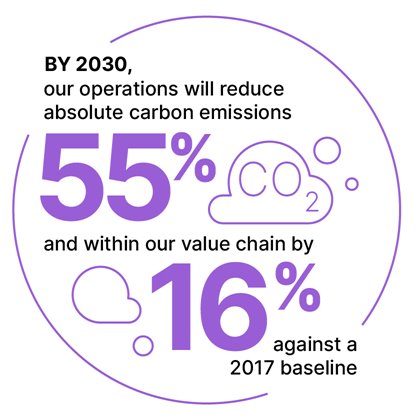
Our 1.5°C target was approved in early 2020 by the Science Based Target Initiative, an international governing body that independently assesses and approves companies’ GHG goals. We are the first aluminum can manufacturer to adopt a science-based target. We will aim to meet the 55% target in two main ways: by switching to renewable energy and by improving energy efficiency in our manufacturing processes.
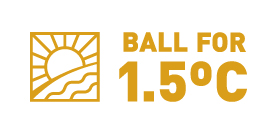
By setting such an ambitious goal, we are striving not only to help with global efforts on climate change, but to improve Ball’s performance and to help our customers reach their own emissions reduction targets – which rely heavily on the carbon footprint of our aluminum cans. Providing support for our customers in this way provides us with a commercial advantage and is a key example of how sustainability supports the strategy that drives our business.
We began to transform the way we embed climate change throughout our business in 2019 with our first internal Climate Summit. Sixty leaders from across the company gathered to generate and commit to actions that will meet our ambitious targets and prepare the company for a transition to a low-carbon economy. Climate Summit discussions focused on four key concepts: 1) embedding the cost of carbon; 2) transformative process innovation; 3) igniting ownership; and 4) addressing value chain emissions.
VALUE CHAIN TARGET
As part of our science-based target, we will aim to cut greenhouse gas emissions 16% across our value chain by 2030.
Around 80% of the GHG emissions associated with our products come from within our value chain rather than our own operations. We collaborate with our value chain partners to make a difference in this area, both ‘upstream’ in the products and services we purchase from suppliers, and ‘downstream’ in the way our products are collected, sorted and recycled.
We are able, for instance, to work with various stakeholders to cut GHG emissions by increasing recycling rates (as we explain in our Real Circularity webpage), and we can also help to reduce downstream emissions (such as through transportation) by lightweighting our cans.
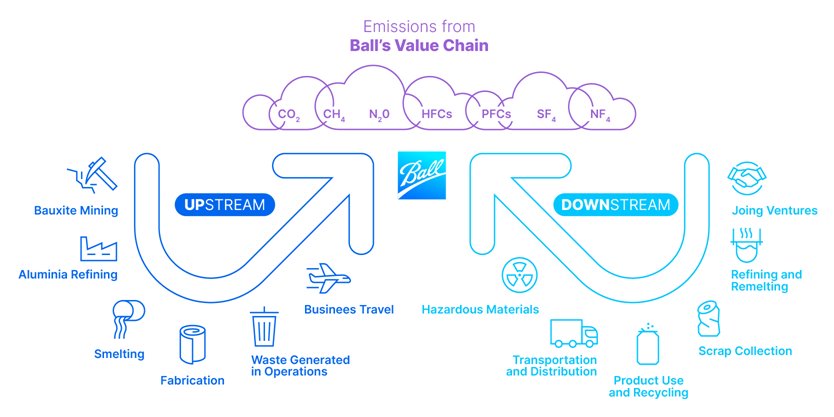
Emission Reductions in our Operations
In order to meet our scope 1 and scope 2 science-based targets, Ball is switching to renewable energy and improving energy efficiency in our manufacturing processes. Learn more about our critical initiatives and how we are executing on them.
Emission Reductions in our Value Chain
We align our Scope 3 emissions reporting with the “Corporate Value Chain (Scope 3) Accounting and Reporting Standard” published by the World Resource Institute (WRI) and the World Business Council for Sustainable Development (WBCSD). Accordingly, we evaluated GHG emissions from 15 categories covering upstream emissions, like those from our suppliers, and downstream emissions, such as those from our customers.
Our 2020 Scope 3 emissions include the following categories: purchased goods and services (83% of total, including end-of-life treatment of products), capital goods (5%), fuel and energy related activities (2.8%), upstream transportation (3.6%), waste, business travel, employee commuting, downstream transportation, processing of sold products (all less than 1%), and investments (3.8%). Seventy percent of our Scope 3 emissions originate from the metals we convert in our plants.
Detailed insights in our Scope 3 emissions allow us to identify relevant risks and opportunities associated with emissions from our value chain, develop reduction plans and engage value chain partners in meaningful mitigation actions.
Carbon Footprints of our Products
Life cycle assessment (LCA) is a valuable tool to track the carbon footprint of our products. In 2020, we published a peer-reviewed comparative LCA for aluminum beverage cans, PET and glass bottles as well as beverage cartons in Brazil, Europe and the United States. Among other findings, the study revealed that recycling is a key factor when it comes to the sustainability profile of all substrates.
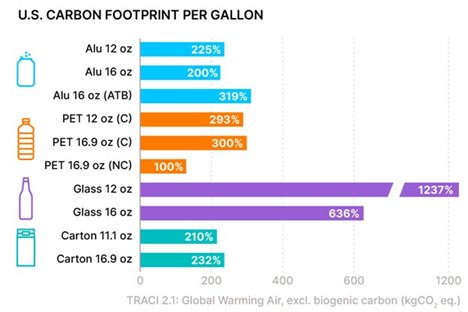
To the right is a representative example for the LCA analysis of the U.S. Here, the LCA found that with today's actual recycling rates and recycled content, aluminum cans have a lower carbon footprint compared with glass bottles and PET bottles for carbonated beverages. This LCA also covered various sensitivity analysis and scenarios. For example, it shows that beverage cans have the highest carbon footprint variability when recycling rates, recycled content, and container weights are changed. Therefore, the cans' environmental impacts will benefit more than other substrates from increasing recycling rates, higher recycled content and lower container weights.
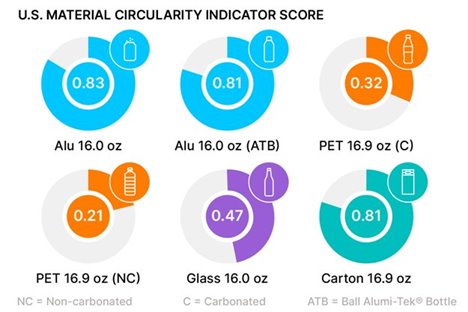
To move from linear to circular thinking, this study also applied the Material Circularity Indicator (MCI) methodology developed by the Ellen MacArthur Foundation. Related scores allow interested parties to understand to what extent different packaging options are a good fit for the circular economy. MCI scores range from 0.1, a linear product, to 1, a perfectly circular product. In all three regions, aluminum cans achieve the best material circularity scores of any single-use packaging option. Despite the fact that beverage cartons are challenging to recycle, the MCI methodology considers paperboard from sustainable sources as fully circular. The study results underline that by increasing efficiencies in our own operations and within our supply chain, switching our electricity use to renewable energy, and-- most importantly-- working with our customers, suppliers and other partners to increase recycling rates, the environmental profile of aluminum cans can be further enhanced, making cans a low carbon and circular package of choice.
The full LCA report, regional summaries and additional information about the LCA can be found here.
